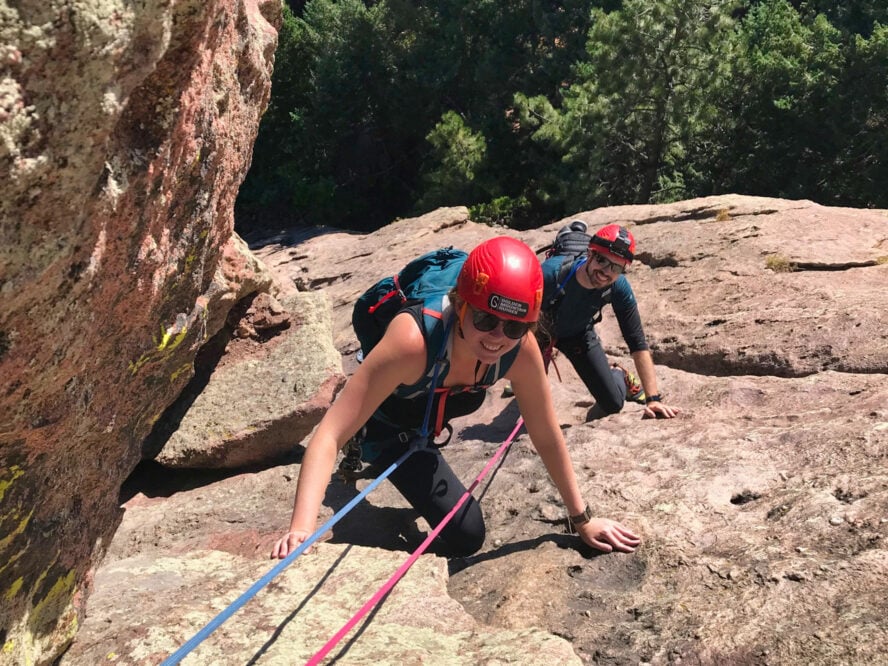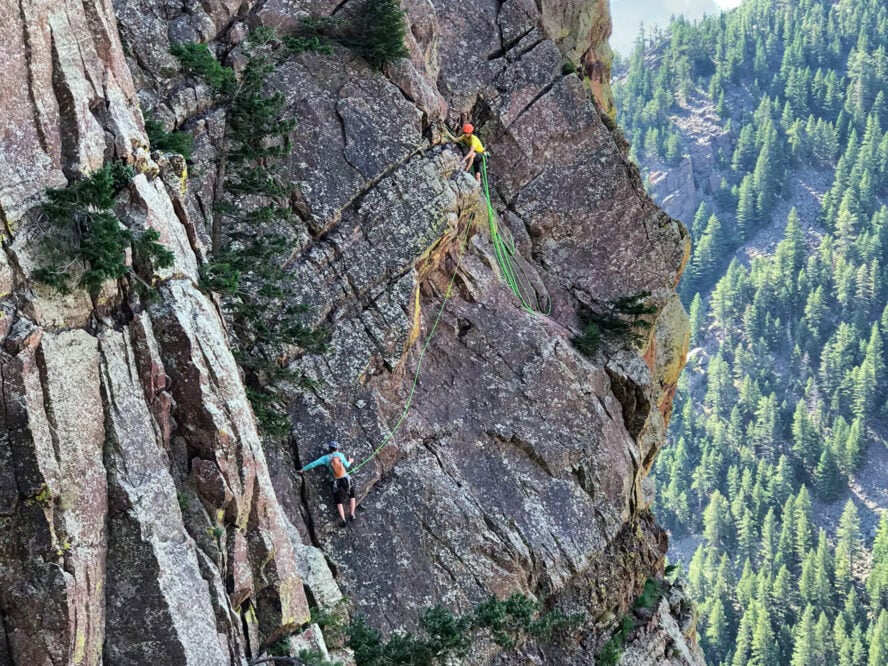Your first arrival in Boulder becomes unforgettable thanks to the snow-capped Colorado Rocky Mountains in the distance and the striking Flatirons looming above town. Just minutes from Boulder’s downtown hub, The Flatirons feature some of the best beginner multi-pitch climbing in the US, as well as old-school climbs like The Northwest Passage and The Maiden’s splendid North Face. For climbers, the last minutes driving into town are spent eyeing potential lines on the thousand-foot faces.
Having lived in Boulder for 30 years — it’s where my guiding business was born — I can attest that it’s a destination unto itself, and a must visit if you’re coming to the Front Range for climbing. Here’s my insider info on climbing in the Flatirons — the routes, the rock, and the gear you need to bring to make the most out of this climbing playground.

Pros and Cons of Climbing the Flatirons
With some of the best multi-pitch climbing routes in Colorado, including fantastic single-pitch sport and even world-class bouldering, the Flatirons are actually a handful of faces. Locals name routes on ‘The First,’ ‘The Second,’ and ‘The Third’ due to the sheer abundance of options.
As an outdoor capital, climbing in the Flatirons has a decidedly Western feel. You’ll take forested approaches under the watchful eyes of mountain lions and black bears. Temperatures can soar in the summer, so start early if it’s going to be hot. You’ll also enjoy seemingly endless days of sunshine, and if you pay attention, spot more than a few wildlife sightings.
What kind of rocks are the Flatirons?
The famed “Flatirons” are slanted, red sandstone formations deposited by an ancient inland sea over 300 million years ago. Erosion developed the eastern section of the Rockies into Boulder’s iconic jagged foothills. The east faces of the rocks feature slab climbing on everything from fourth-class scrambles to spooky, runout 5.9 sketch-fests. There are officially five numbered flatirons and dozens of other formations near them, all covered in quality climbing. Take your pick, and find out the wealth that Front Range climbing has to offer.
Plan your climbing approaches beforehand
I always spend some time figuring out approaches, which range from minutes, such as the site of my first trad lead in 1986 at Gregory Amphitheater, to hour-plus scrambles on deer trails. The Flatirons sit above Boulder’s Chautauqua Park, which has an enormous, well maintained trail system. We’re talking about uploading a map into your phone or spending a few minutes finding your route at the trailhead. I recommend Jason Haas’s excellent guidebook Climbing Boulder’s Flatirons and Richard Rossiter’s Rock Climbing the Flatirons. Both are accurate and helpful, although Haas’s title has been updated most recently.
The classic east faces and the steeper west faces
The sheer volume of quality rock means if you’re willing to walk a bit, you can escape the crowds. I will warn you: crowds are common on Boulder’s lively Front Range. Once you’ve ticked the classic east faces of the First, Second, and Third Flatirons — or any of the other rocks like the Maiden, the Matron, Satan’s Slab and more — you can venture to the steeper west faces. Old-school routes like the Maiden’s West Overhang, or newer sport routes like I Am the Walrus (5.14) are incredibly popular and worth checking out.
My favorite climbs? We’ll get to that. But watching the sunrise from a pitch up the First Flatiron’s Direct East Face is a rite of passage.
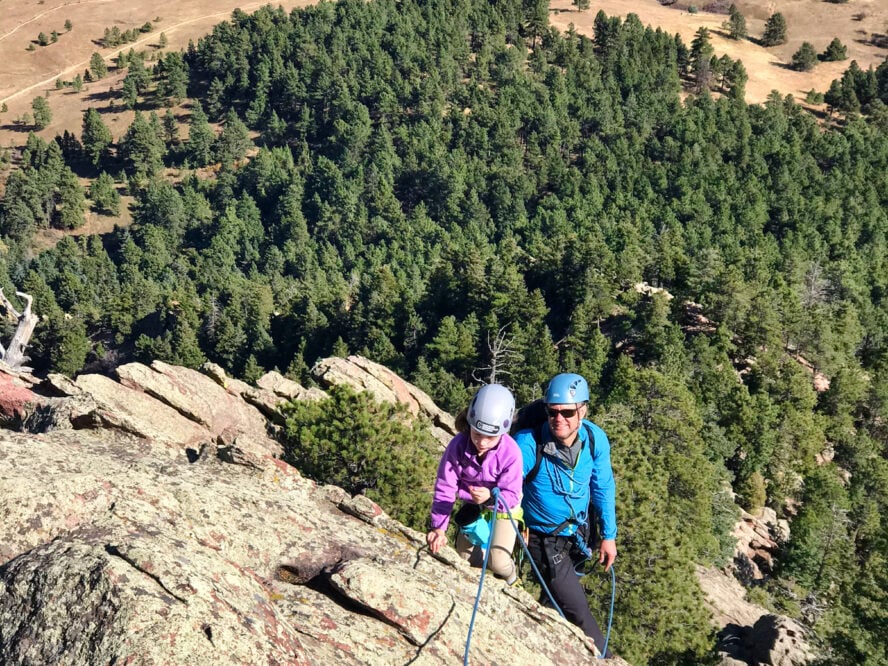
Beginner Trad: Prepare for Runout Climbing
Browse the guidebook and you’ll notice a collection of five-star routes in the 5.3 to 5.6 range. Some of them stretch to 12-pitch journeys. I find them well worth doing, but be advised: These beginner routes often require long runouts on albeit easy terrain.
The First’s Direct East Face is indeed one of the great 5.6 multi-pitches in the West. I also realize the first pitch is extremely runout, leaving climbers with only two bolts and a couple of potential gear placements in a span of 200 feet. Many aspiring leaders have seen the approachable grade, read “bolts” and walked to the base — only to find an intimidating 40-foot runout to the first bolt. Heads up!
If you’re comfortable with pushing it a bit and you’re psyched with route-finding and gear placements, then the east faces of the First, Second, and Third offer some of the most incredible and beginner-friendly multi-pitch climbing. The Third’s east face has a legendary 5.3 on it. You’ll want to bring wide gear for this iconic climb. The Second Flatiron also is routinely soloed by trail runners.
That being said, people have died on all of these routes, so please think twice about soloing or “going for it.” Many of the east facing routes end in rappels, for example. Newer leaders need to make sure their rap skills are dialed. I recommend using a third-hand backup, taking your time, and until you know why and when to simul-rap, don’t do it.
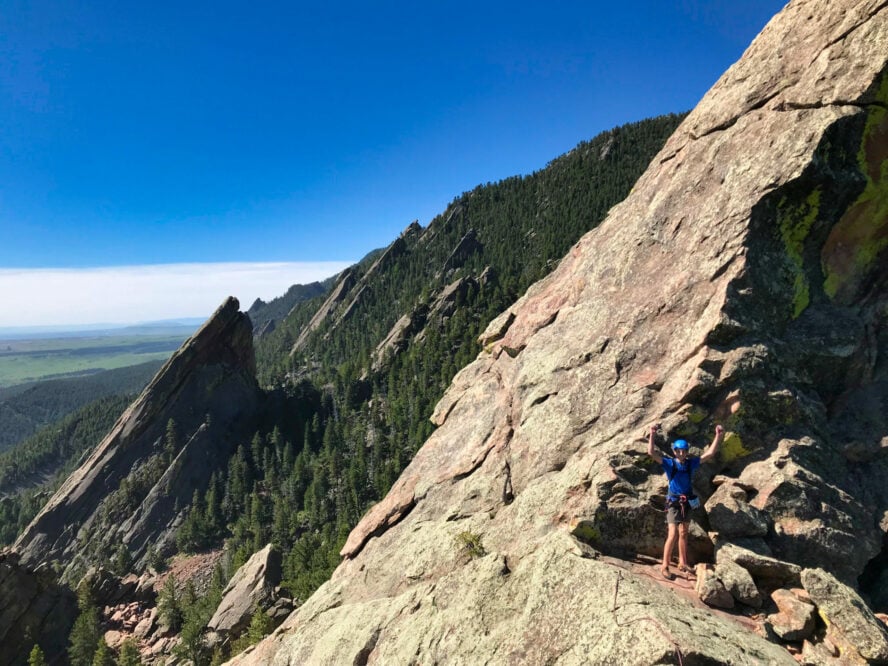
Don’t Miss These Flatirons Super-Classics
For Colorado climbing, the Flatirons hold some of the best routes in not just the whole state, but the whole country. I’ve included a smattering of a few of the super-classics not to be missed.
1. Direct East Face, 5.6R, First Flatiron
Over 1,000 feet long, with only a handful of bolts, this route is no joke. The hardest climbing you’ll find is probably right off the ground. If you can make it to the second bolt, then the tough climbing is behind you, but don’t let your guard down. You’ve still got a lot of rock to cover. There’s a bail-out on the north ridge if you need to, but I really encourage you to try and send the whole thing. It’s a great route for anyone looking for a satisfying challenge.
I’ll add one last thing. When you go to the east face of the First, don’t use the spindly little tree at the first belay as an anchor. The poor thing is barely hanging on. There’s a good gear anchor up and left about two meters. Spare the tree, we’re here to enjoy nature after all.
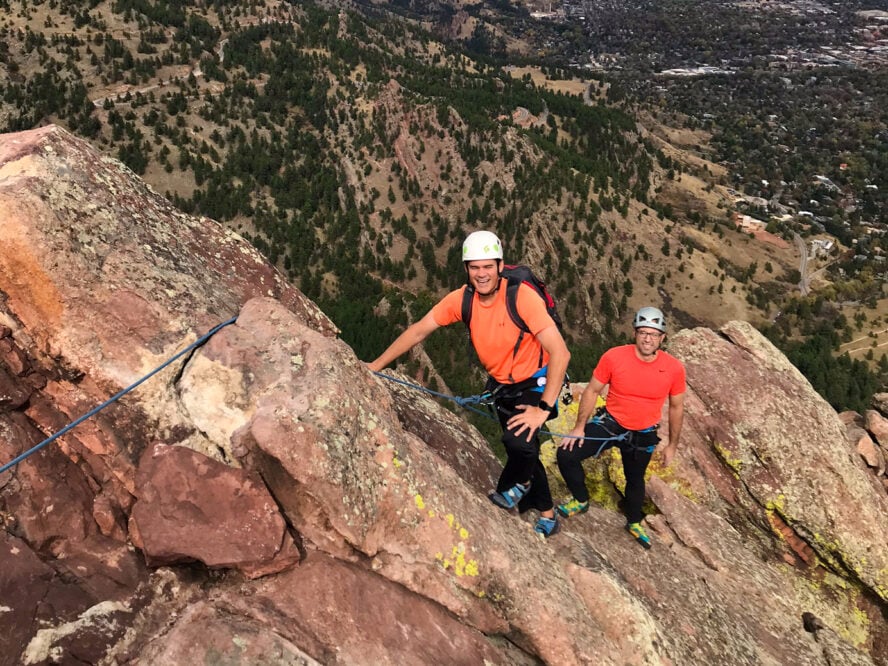
2. Standard East Face, 5.3, Third Flatiron
Long, mellow, scenic, and fab, Rossiter called this perhaps the greatest beginner climb on the planet. I might agree. The climbing is indeed relaxed, but the gear is well-spaced. You’ll find an old line of eye-bolts offering belays on the way to the summit, but they aren’t on the best belay ledges. Bring enough gear to protect yourself and have the option to build belays. Natural horns and threads abound, so you’ll also need to keep your eyes peeled. Three single-rope rappels get you down or one single and one double-rope rappel. My pro tip: Do the double-rope. Your drop is almost a full 60 meters of nearly dead vertical. That’s what I call awesome.
3. North Face, 5.6s, The Maiden
This route is scarier and sketchier for the follower than the leader. I’d also call it another funky, awkward-to-protect route at an amenable grade. Like many of the rocks in the Flatirons, the North Face tops out in a compact, scenic, memorable summit. You also get one of the best rappels anywhere: the complete overhanging drop to the Crow’s Nest. Get yourself ready!

4. East Ridge, 5.10+, The Maiden
Anticipate a striking line up the narrow, east arete of the Maiden. You get the same summit as the North Face route and the epic rappel. You’ll run into a protectable crack at the first crux, with a bolt-protected crux above that. Trust me, this is a great route and great summit.
5. Death and Transfiguration, 5.11, Fourth Flatiron
Stout, sustained, well-protected on the tough bits, Death and Transfiguration is a super-classic route in the Flatlands. Imagine the hard climbers of the ‘70s up there in their painters’ pants and climbing with nuts and hexes. I’m not afraid to admit that they were tougher than us.
My take on the Flatiron’s sport routes
Oh, sport routes! If you’re in the market, you’ll find a bevy of hard, steep, sport routes that have gone in over the last 20 years. Climbers like Matt Samet, Ted Lanzano, Chris and Heather Weidner, and Jonathan Siegrist have established burly test pieces into 5.14. Truth be told, I haven’t clipped a bolt on a single one of them. Too hard for me, but they sure look nice. Grab a guide, a guidebook or some locals and go get some.
Where to go bouldering in Colorado?
My knees and ankles refuse to boulder these days, but I see all the strong kids doing it and it looks fun. Why didn’t we use bouldering pads in the ‘80s? Seriously, pad-toting killers have developed a bunch of attractive bouldering on the Front Range, some of which is in the Flatirons. Matt Samet and Philip Benningfield’s new title, Colorado Bouldering, published in 2020, will get you to the routes you’re after.
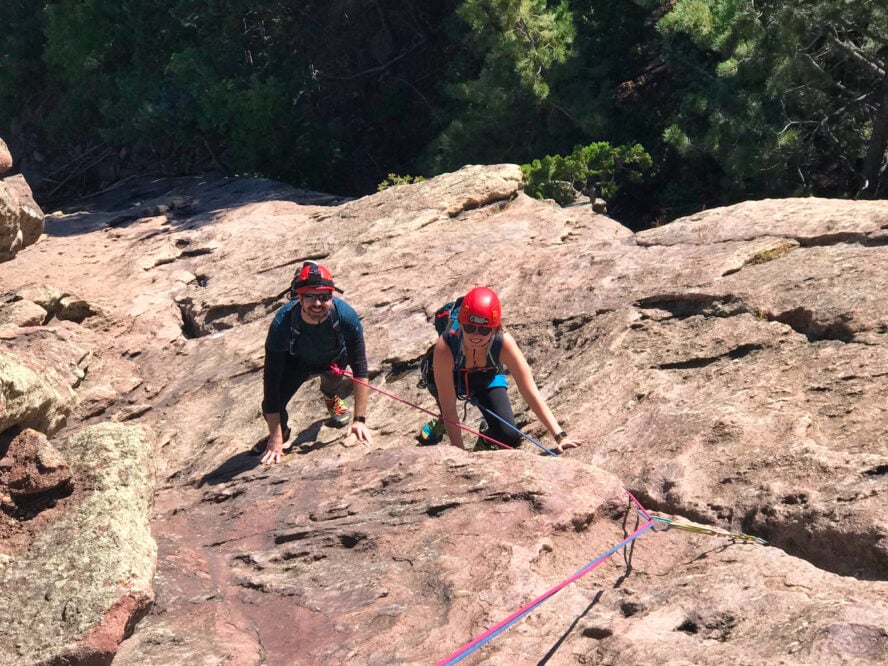
My Advice for Visiting Boulder’s Flatirons
From the weather, when to go, to what gear to pack, here’s some tips for visiting the Flatirons from someone who lived and climbed in the area for three decades.
When is the best time to climb in the Flatirons?
The best time of year to climb in the Flatirons is spring and fall, but it’s definitely a spot you can find yourself in year-round. It can be wicked hot in summer, so plan ahead. I recommended wearing a sun hoody on east-facing routes, unless you climb them in the late afternoon — sometimes a great strategy. Let the crowds suffer in the morning heat and start up after the sun goes behind the formation! Also, bring a headlamp and stay to enjoy the sunset.
All the crags sit on the east aspects of Green Mountain and Bear Peak. This makes it difficult to see approaching weather. Fortunately you’ll have cell coverage in much of the zone, so check the weather before you go. Check the radar periodically for any chance of rain, or more alarmingly, thunderstorms. The last place on the planet you want to be is the summit of the Third Flatiron with lightning crashing around you.
Don’t forget a rain jacket and puffy in the winter, and at least a wind layer in the summer. Weather changes quickly in Boulder, meaning it can snow, sleet and hail any time of the year. I bring sunscreen and plenty of extra water when it’s hot.

Gear I recommend packing for the Flatirons
You’ll need a varied rack, unless you’re clipping bolts on the sport routes. Flatirons rock offers everything from wider cam placements, usually sizes 2 to 4, to slung horns where you’ll need extra double-length runners to good nuts. The emphasis is on bigger gear, though you can find some smaller nut placements, too.
If you’re on the many moderates, wear comfortable shoes. If you’re renting shoes down in town (Neptune Mountaineering and Rock ‘n’ Resole both do so), size them at almost your street-shoe size — don’t let the kid fitting you give you tight shoes. Slab climbing requires comfortable shoes and not nearly the snug fit of a sport shoe, so err on the side of comfort. Trust me!
For cruisy multi-pitch, it’s nice to spend the entire day in versatile approach shoes designed to hike with heavy packs, climb up lines and traverse ridges. If you’re walking into something more challenging, consider if the trails are rocky and some of the walk-offs loose and tricky to pack accordingly.
My personal voodoo for guiding the First and Third is to walk in with a comfy, huge pack, with extra water for me and my guests. Leave the heavy pack at the base and bring a lighter pack to carry on the climb. I then snag the big pack on the way down—and a cold drink to celebrate.

Plan ahead for seasonal closures in the Flatirons
Keep in mind the city and county of Boulder, as well as the Eldorado Canyon climbing routes, close certain formations at different parts of the year for nesting birds. The Third Flatiron is closed February 1 until July 31 every year. Do not risk disturbing the birds (and a fat ticket for you!) by climbing on these formations during closures. The city and county list clear closures on their websites, so research them before heading out. Locals do not poach these formations. You shouldn’t either.
Things to do in the Flatirons other than climbing
Years ago, I had a bachelor party out in the Flatirons, a fun crew of dudes in their late 20s. The most tatted-up, muscular of all of ‘em stood at the base and watched me climb the first pitch of the Third’s East Face (5.3). I pulled the ropes and prepared to belay them up, and he loudly announced, “I can’t do it. I’m out.” His buddies wailed and heckled him, all in good fun, but it was ironic that this dude looked like an MMA fighter and wanted no part of the slabby, mellow climbing. Fair enough. He untied, dropped the rope and put his trail shoes on.
From above, I quickly described a hike he could do that would put him near the summit when we finished, and he disappeared down the trail.
The point is, you and your crew will find a ton of other activities to do in Chautauqua Park and the Flatirons. The hiking and trail running in the Flatirons are awesome. If you run south, you will hit Eldorado Springs, where you can swim in the cold springs pool. The birding can have you spotting nesting Prairie Falcons (or are they Peregrines?!). If we have a wet spring, there are also scores of wildflowers out in the early summer. Bikes are unfortunately banned in that part of Boulder’s open space, so no cycling.
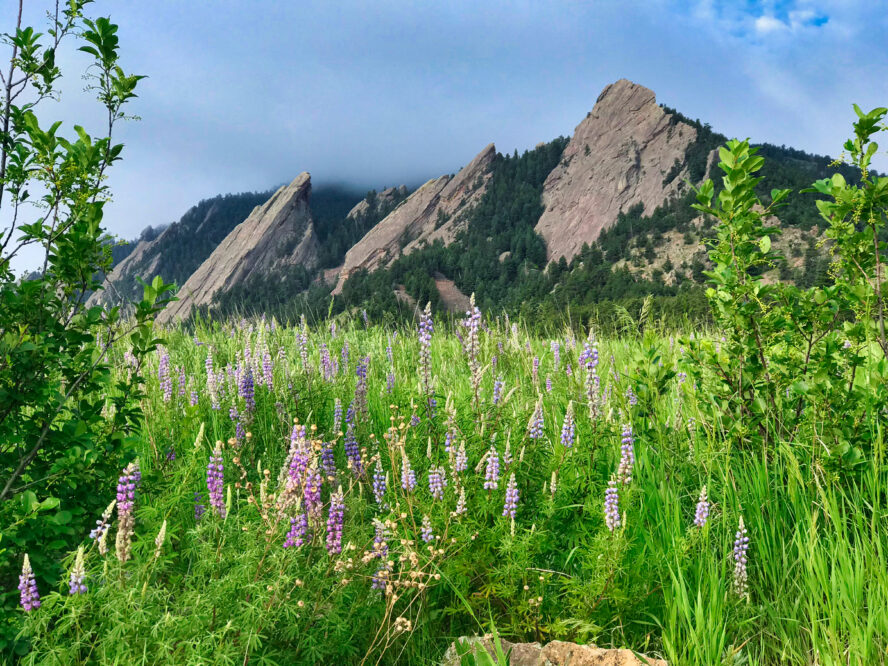
You’re also a short walk from town, so as soon as you’re psyched on food, drinks, lounging or people watching, you can drop down to town. The National Center for Atmospheric Research (NCAR) is reachable by trail or car, with good climbing near it. The angular, rust-colored building was designed by Chinese architect I.M. Pei. I highly recommend you check it out.
If you’re in need of a guide
Front Range climbing guides with local knowledge will show you the best spots and help you avoid crowds. Level up your skills faster under the guidance of a professional while staying safe and fast tracking your learning.
If you’re looking for a more social way to upgrade your climbing, consider some of the gym-to-crag or multi-pitch rock climbing camps offered here.
Want to learn more about what makes the Front Range a premiere climbing destination and why it’s the perfect place for an all-women’s weekend climbing camp? Watch AMGA guide Jess Worley discuss the area in this 57hours Adventure Talk:



